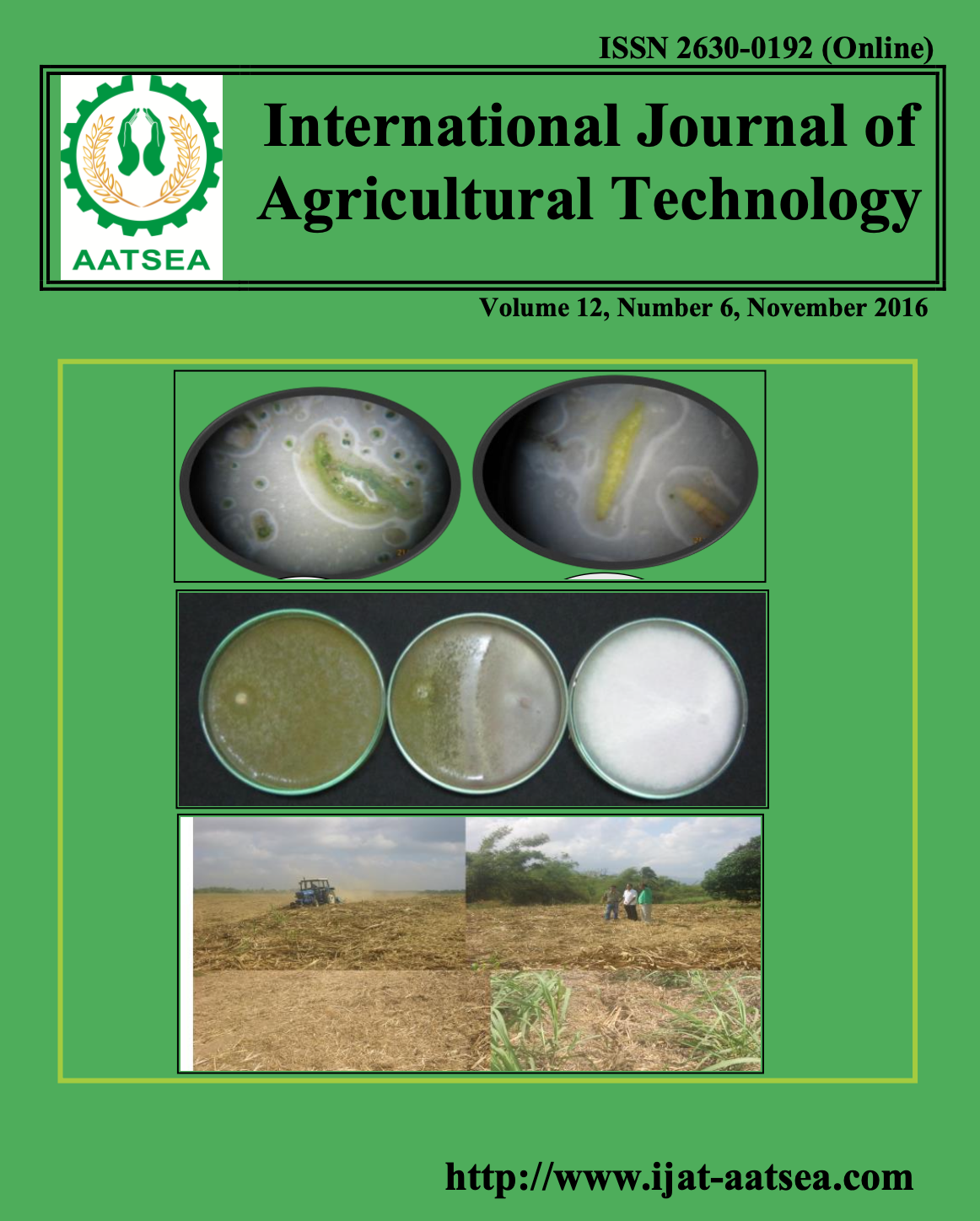Diversity of Postharvest pathogenic fungi of green bean pods in Egypt
Main Article Content
Abstract
In Egypt, rot disease of green bean pods (Phaseolus vulgaris. L) is the major problem during storage and marketing. Sclerotinia sclerotiorum andBotrytis cinerea were most dominant fungi followed by Alternaria sp., R. solani and Fusarium sp. Sclerotinia sclerotiorum was the most dominate fungi isolated from rotted pods collected from different markets in Egypt. All the tested fungi were able to infect pods of green bean Valintino Cultivare. The highest records of disease infection (80 and 75.6 %) on green bean pods were found with two isolates of S. sclrotiorum (Sc 11 and 13). But the two isolates of Botrytis cinerea isolate 2, 1 and 3 show moderate disease incidence .Meanwhile, other isolated fungi cause the least records of rot disease incidence on faba bean pods. Physiological studies Cleary show that there is a variation among tested isolates of S. sclerotiorum according to pathogenic ability, linear growth, the number and size of sclerotia .
Article Details

This work is licensed under a Creative Commons Attribution-NonCommercial-NoDerivatives 4.0 International License.
References
Abuel-Ela, M. M. G. (1993). Studies on white mould disease caused by Sclerotinia sclerotiorum on some vegetable crops. (Master ‘s thesis) Faculty of Agriculture, Cairo University. 83 pp.
Ahmed, F. A. (2010). Studies methods of controlling postharvest bean and pea diseases. (Master ‘s thesis). Faculty of Agriculture, Benha University. 137 pp.
American Public Health Association (1960). Standard Methods forthe Examination of Dairy Products. 11th edition. APHA Inc., NewYork.
Barnett, H. L. and Hunter, B. B. (1972). Illustrated genera of imperfect fungi. Burgess Industries Inc. in Minneapolis, USA. 241 pp.
Catherine, C. O., Chardonnet, C. E., Sams, R., Trigiano, N. and William, S. C. (2000). Variability of three isolates of Botrytis cinerea affects the inhibitory effects of calcium on this fungs. Phytopathology 90:769-774.
Ellis, M. B. (1971). Dematiaceous Hyphomycetes. Commonwealth Mycological Institute, Kew., Surrey, England. 608 pp.
Fahiem, M. A. (2010). Studies on bean fruit in Egypt. (Master ‘s thesis). Faculty of Agriculture, Benha University. 137 pp.
Fath El-bab, T. S. and El-Mohamedy, R. S. R. (2013). Bio-priming seed treatment for suppressive root rot soil borne pathogens and improvement growth and yield of Green Bean (Phaseulas Vulgaris L.,) in New Cultivated Lands. Journal of applied sciences research 9:4378-4387.
Fang, Y. C., McGraw, A. C., Modjo, H. and Hendrix, J. W. (1983): A procedure for isolation of single-sporecultures of certain endomycorrhizal fungi. New Phytologist 95:107-114.
Gilman, J. C. (1957). A manual of soil fungi .Second edition. The lowa State College Press, Lowa, USA. 450 pp.
Hatamleh A. A., El-Sheshtawi, M., Elgorban, A. M., Bahkali, A. H. and Al-Sum, B. A. (2013). Pathogenicity of Scleritinia sclerotiorum to Bean (Phaseolus vulgaris, L.) cultivars. Journal of pure and applied microbiology 7:3275-3279.
Howard, R. J. (1981). Ultrastructural analysis of hyphal tip cell growth in fungi: spitzenkorper, cytoskeleton and endomembranes after freeze-substitution. Journal of Cell Science 48:89-103.
Hawker, L. E. (1950). Physiology of Fungi. University of London Press, LTD. Warwich square, London.
Khalil, M. I. S. (2010). Pathological studies on white rot disease of legumens vegetables. (Ph. D. Thesis). Faculty of Agriculture, Suez Canal University, Egypt. 135 pp.
Naffa, A. M. A. and Rabie, S. M. H. (2006). Role of Dipping cucumber fruits in salt solutions and packaging to control pathogenic fungi and preserving quality during cold storage. Minufiya Journal of Agricultural Research 20:1403-1417.
Shah, D. A. and Dillard, H. R. (2007). A spatial hierarchy model for the incidence of Sclerotinia sclerotiorum in snap bean. Phytopathology 97:107.
Sharif, A. M., Lrani, Z. and Weerakoddy, V. (2010). Evalating and modeling constructs for e-government decision making. Journal of the Operational Research Society 61:929-952.
Siviero, P. and Motton, M. S. (2000). The enemies of the narrow. Informatore Agrario 56:39-49.
Snowdon, A. L. (1992). Reported that Pythium, Fusarium caused white cottony rot, Botrytis cinerea caused gray mould, Sclerotinia sclerotiorum caused white soft rot to bean pods. Color atlas of postharvest diseases and disorders of fruits and vegetables. Volumn 2. CRC press, Boca Raton FL. pp. 236-262.
Steel, R. D., Torrie, J. H. and Dickey, D. A. (1997). Principles and procedures of statistics: a biometrical approach. Third edition. McGraw–Hill Inc., New York, USA. 612 pp.
Soltan, H. H. M. (1993). Pathological studies on some diseases of snap bean pods during storage and exportation. (Master ‘s thesis) Faculty of Agriculture, AL-Azhar University. 117 pp.
Suslow, T. V. and Cantwell, M. (1998). Peas - snow and snap pod peas. Perishables Handling Quarterly 93:15-16.
Williams, J. H., Phillips, T. D., Jolly, P. E., Stiles, J. K., Jolly, C. M. and Aggarwal, D. (2004). Human aflatoxicosis in developing countries: a review of toxicology, exposure, potential health consequences, and interventions. The American journal of clinical nutrition 80:1106-1122.
Wijnands, J. H. (2004). The impact on the Netherlands of the Egyptian greenhouse vegetable chain. LEI. The Hague, Netherlands.
Spalding, D. H. and Reeder, W. F. (1974). Post-harvest control of Sclerotinia rot of snap bean pods with heated and unheated chemical dips. Plant Disease Report 58:59-62.


